The dawning light found me 18 feet up a familiar fir tree, with my body trembling like an autumn leaf. I was unable to tell whether it was from excitement or the chill in the air that this southern boy wasn’t used to. After all, two days before I was home in humid Louisiana where first light’s temperatures in the mid to upper 80’s give way to upper 90 and 100 degree temperatures by noon. Here at 9,800 ft. in southern Colorado the temperature was right at 40 degrees, and it was perfect. The clean, crisp air smelled like Christmas with the mixed scents of spruce and pine. As darkness gave up its hold on the mountain, and the morning light began fighting off the chill in the air, I glanced down at the bow in my hand and the challenge I was up against started to sink in.
Why did I bring a 50 lb. recurve to the mountains to hunt elk? This prospect was starting to feel a little crazy, especially since it usually takes a couple of years to get drawn for a tag that could leave a non-resident short an arm and a leg. Plus, I drove 900 miles to be here. However, the challenge of taking an animal the size of an elk with traditional gear was something that had always intrigued me. Looking down the trail through the spruce boughs, I couldn’t help but wonder if I had made a mistake bringing my recurve.
The ground below me was riddled with fresh scuff marks where hooves had slid in the pine duff and dirt at an intersection of three trails a mere 12 yards from my tree. Dusting off memories of hunts from years past, I could not recall all of the deer and elk that had been harvested and seen from this one particular tree. Those memories, along with the tacky sap glistening in the sunlight on some saplings that had been twisted and mangled by the tines of a frustrated bull, renewed my confidence and I was certain I had made the right choice.
Friends back home had chided me for wanting to harvest an elk with a recurve. I had only been hunting with traditional gear for one year, and was told I would regret bringing “my stick” with me to the mountains. To them, tag soup was inevitable. Even the local Game Warden, who stopped by camp the afternoon we arrived in the mountains, chuckled when he found out I brought a recurve from Louisiana to hunt elk. “Are you planning to shoot a cow if you see one?” he asked. A loaded question, I surmised by the grin in his eyes. I smiled and replied with a slight air of cockiness, “No sir, I’m going to hold off for a bull.” This was met with more laughter and chiding. “You may think that now, but when you have a cow standing in front of you, you’ll change your mind. Out-of-towners always do.” I reassured him with a grin that I didn’t think so. This brought a big friendly smile, and with all sincerity he wished me luck and told me he would come back to check in on me in a few days. I poked back, “Come expecting to see antlers in camp.” He laughed and very colorfully said, “Boy you’re a ‘big’ talker. I like that.” As he left camp I remember smiling confidently to myself and thinking ‘I’ll prove him and the guys back home wrong.’ I couldn’t help but be confident because I had a secret. I wouldn’t be stalking and calling from the ground like the locals, or other elk hunters on television.
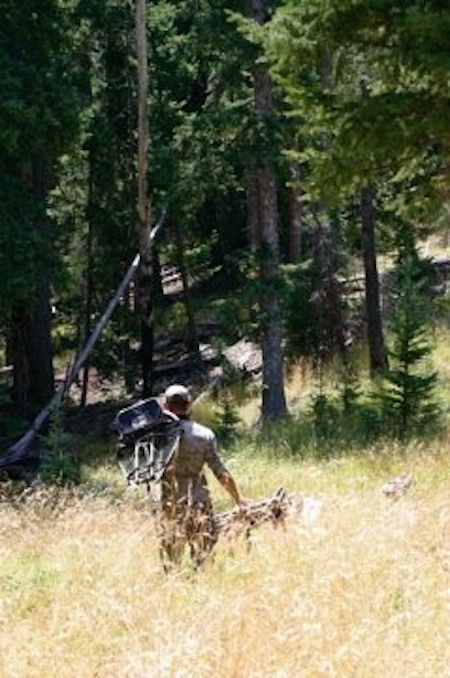 Earlier that morning, I hung a treestand in a lonely spot on the backside of a mountain between some well-used game trails. There was a gently rolling meadow at the top of one side of the ridge, with scattered aspen groves where deer and elk liked to feed. The back side of the ridge was a stark contrast that dove down into a series of ravines clothed in dark timber and littered with fallen trees. A grid-work of trails filtered down from the meadow into the timber and deadfalls, which provided cover for midday naps. Over 20 years before, my dad walked one of these trails and found a place where several of them converged into one trampled pathway that disappeared into the fir trees down the ravine. It was there I positioned my stand in a pinion pine, in timber that had been freshly decorated with a splattering of big rubs.
Earlier that morning, I hung a treestand in a lonely spot on the backside of a mountain between some well-used game trails. There was a gently rolling meadow at the top of one side of the ridge, with scattered aspen groves where deer and elk liked to feed. The back side of the ridge was a stark contrast that dove down into a series of ravines clothed in dark timber and littered with fallen trees. A grid-work of trails filtered down from the meadow into the timber and deadfalls, which provided cover for midday naps. Over 20 years before, my dad walked one of these trails and found a place where several of them converged into one trampled pathway that disappeared into the fir trees down the ravine. It was there I positioned my stand in a pinion pine, in timber that had been freshly decorated with a splattering of big rubs.
The next morning I was there, enjoying the solitude and waiting for daylight. I slowly scanned the mountainside, while daydreaming about the satisfaction I would have, given the chance to prove my friends and the warden wrong, when the soft crack of a twig snapped me back to reality. My initial thought was that it was probably a pine squirrel trying to hide a prized mushroom, but turning my head toward the ridge above me, I realized I was greatly mistaken. I was almost face to face with a 5×5 bull, and I was not ready for it. I was still sitting down and facing the opposite direction! The shock of having an animal that large materialize 30 yards from me so silently froze all bodily functions from my normal breathing to my mind processing what I should and should not do. As soon as the bull’s head passed behind a tree, I quickly stood up to get into position. As I did this, the forest exploded with breaking limbs and crashes that sounded like a herd of elephants. I spun around and, to my horror, realized that two bigger bulls–another 5×5 and a 6×6–had snuck in behind me while I was focused on the smaller 5×5. They saw me stand up carelessly in my haste to get into position, and decided they would be safer in the next county. I began cow calling, frantically trying to calm them. This seemed to work. They had apparently caught my movement, but had not actually seen me on the side of the tree trunk. The bulls stopped at 70 yards, looked around nervously and walked off. I sank back into my not too comfortable seat to stew over the events that had just taken place. I was disgusted with myself. Rookie mistake, not scanning the woods before making a major move like that. I blew my only chance…or so I thought.
At this point you may be wondering why I chose to be 18 feet up a pine tree to hunt elk to begin with. My family has been driving to southern Colorado annually for over 30 years, and during that time we have enjoyed numerous successful bowhunts for both mule deer and elk. We always hunt the opening week of the season, when the elk in our unit aren’t responding well to calls and the muley bucks are still in bachelor groups. To compensate, we bring our southern style of hunting with us and apply the same approach to mulies and elk that we use for our southern whitetails. That is, hunting from a treestand on travel patterns between bedding areas and a food source. Bowhunting whitetails is all about reading the details: food sources, bedding areas, and favorite travel routes between the two. However, the most critical of all is finding a tree that has the highest potential for allowing you a shot opportunity, while still offering the cover to hide you. When this method is applied to hunting elk and mule deer, it works beautifully. You rarely hear of people elk hunting from treestands unless it is near a wallow, or in some instances an alfalfa field. Hunting over heavily used trails in dark timber or aspen meadows up in the mountains is not common practice. However, setting up a stand along a well-used game trail is a practice well worth the effort. While other hunters are hiking to vantage points to glass for game, we are wearing the tread off our boots looking at the ground for sign and studying the lay of the land. Whitetail bowhunting experience is invaluable when hunting Western states. The terrain and game are completely different, but one thing remains the same: animals like taking the path of least resistance given their own choice. These paths are usually in the form of saddles on ridgelines or bottlenecks between rock outcroppings and steep draws where animals like to skirt around on flatter ground. Once found, a tree in a location like this can be used year after year.
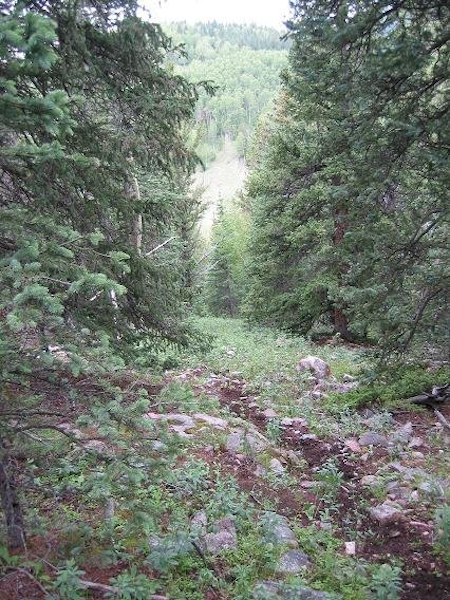 I took my first traditional harvest, a young mule deer buck, in 2011 from such a tree. We had established over the years that this tree was one with the highest shot opportunity potential in the ravine where it was located. We harvested game, or at least had shot opportunities, from that same spot every season. To someone in search of a vantage point to glass from, this was just any other tree along a game trail that took you from point A to point B. But in the mind of a southern bowhunter with an eye for details, it was the holy grail of stand locations. There was a trail that came up a gentle draw from an aspen meadow, skirted a steep rock outcropping at the point of a ridge, then led off into dark timber. The deer were scarce where we hunt in the San Isabel National Forest the year I took that muley, but the few that were around followed their instincts and the path of least resistance right by our stand. The young buck I killed had escorted two does 12 steps from the tree, and was oblivious to my presence when my recurve sent an arrow through his chest and into the ground beside him. He became more evidence that hunting Western game from a treestand holds high success potential. That harvest also signified the death of my compound bow, and the birth of my new found passion–hunting with traditional equipment.
I took my first traditional harvest, a young mule deer buck, in 2011 from such a tree. We had established over the years that this tree was one with the highest shot opportunity potential in the ravine where it was located. We harvested game, or at least had shot opportunities, from that same spot every season. To someone in search of a vantage point to glass from, this was just any other tree along a game trail that took you from point A to point B. But in the mind of a southern bowhunter with an eye for details, it was the holy grail of stand locations. There was a trail that came up a gentle draw from an aspen meadow, skirted a steep rock outcropping at the point of a ridge, then led off into dark timber. The deer were scarce where we hunt in the San Isabel National Forest the year I took that muley, but the few that were around followed their instincts and the path of least resistance right by our stand. The young buck I killed had escorted two does 12 steps from the tree, and was oblivious to my presence when my recurve sent an arrow through his chest and into the ground beside him. He became more evidence that hunting Western game from a treestand holds high success potential. That harvest also signified the death of my compound bow, and the birth of my new found passion–hunting with traditional equipment.
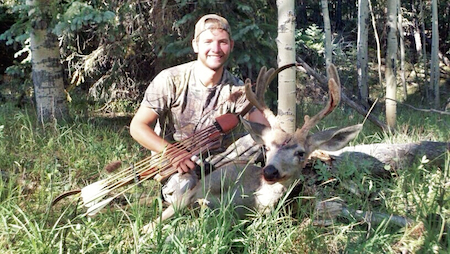 Since I first started bowhunting in Colorado, I can’t recall the number of hunters who have “stalked” the trails under my tree, completely unaware of my presence or the fact they had pushed game by my stand just prior to their passing. We have had the same hunters stop by camp complaining about a lack of game animals in the area, when I had been seeing plenty of game from my tree. I know there is plenty to be said for spot and stalk hunting out West. I personally love it, and many places call for it. However, over the 30 years my family has been traveling west to bowhunt, we have always enjoyed greater success hunting from our treestands than the locals who hunt on foot. The area of National Forest that we hunt in is just that…forest. It is not open, brushy land that is conducive for long sits glassing. It is dense forest where the animals usually spot you before you see them. For this reason, we have always preferred treestands.
Since I first started bowhunting in Colorado, I can’t recall the number of hunters who have “stalked” the trails under my tree, completely unaware of my presence or the fact they had pushed game by my stand just prior to their passing. We have had the same hunters stop by camp complaining about a lack of game animals in the area, when I had been seeing plenty of game from my tree. I know there is plenty to be said for spot and stalk hunting out West. I personally love it, and many places call for it. However, over the 30 years my family has been traveling west to bowhunt, we have always enjoyed greater success hunting from our treestands than the locals who hunt on foot. The area of National Forest that we hunt in is just that…forest. It is not open, brushy land that is conducive for long sits glassing. It is dense forest where the animals usually spot you before you see them. For this reason, we have always preferred treestands.
This is why, on the second day of the previously mentioned elk hunt, I was perched in the dark timber on the same tree where I sat the day before, filled with anticipation of what daylight might bring. Early season elk are still somewhat in their summer routines, with fairly consistent travel patterns, so three bulls coming in together the morning before thrilled me, even though they had been spooked by my rookie mistake. My cow calling seemed to have calmed them enough that I had a suspicion I would meet them again before my return to Louisiana. I did not realize how soon that suspicion would prove to be true. I’ve noticed when Western animals catch your movement in a tree they may get uncomfortable enough to leave the immediate area, but since you are above eye level they are often quick to forget since they don’t see you as a direct threat. I assumed this was what happened on the previous morning, based on how quickly the bulls slowed down when I called to them.
This morning I decided I would be ready for the elk should they decide to come from the ridge above me again. At gray light I was already standing, bow in hand, video camera facing uphill, ready to go. The elk did not show until an hour after daylight on the previous day, so I figured I had a little time to actually be fully awake before something showed itself. Boy was I wrong. I was again searching the mountainside for movement in the lowlight when I saw black legs walking steadily toward me behind a thick spruce tree at 28 yards. Then I caught a glimpse of a long ivory colored tine. I immediately turned on my camera and got ready. The bull that appeared was everything I could hope for in my first elk with traditional equipment…any equipment for that matter. I quickly recognized him as the 6×6 I had spooked the day before, and began focusing on a spot on his chest to calm my nerves.
He came down the ridge toward me and, as if he read the script, he stopped at 14 yards and turned quartering away from me to smell of something on the trail. The next thing I remember was the bull crashing off with my arrow buried almost to the fletching, several inches behind his ribs, but angling into the chest. I fell back in disbelief. I wasn’t even fully awake yet, and the sun had not yet found its way through the dense spruce boughs around my stand. On the backside of a mountain, in the dark timber where loneliness meets paradise, I realized I had just shot my best bull with a 50 lb. recurve on the second morning of the Colorado elk season, on public land, and I had it on film! I had a mix of emotions from pure ecstasy to extreme worry, for I knew my hit was much further back than intended. I knew my arrow would kill the bull, but finding him may prove difficult. I returned to camp to wake up all the non-hunters and tell them the news. We shared hugs, handshakes and an anxious breakfast. We decided to wait for the other hunters to return to camp, and gave it a full four hours before taking up the trail, since I knew my shot was less than perfect. I can’t count the number of silent prayers I sent up in that four hour period, hoping that my bull would not go far. Upon returning to my tree, we discovered there wasn’t much sign other than scuff marks of running hooves in the pine duff. A few hundred yards down the trail we began to pick up decent blood. Within a short time we realized the bull was running down the end of the ridge I was hunting on. As we got closer to the end of the ridge, our trailing turned into searching the deadfalls and brush for the bull itself, rather than sign he left behind. Suddenly, I saw it. Sticking up behind a fallen log was the beam of a bedded bull. There, in a bed that I’m sure he had used many times before, overlooking a steep ravine where he had once been king, the bull died.
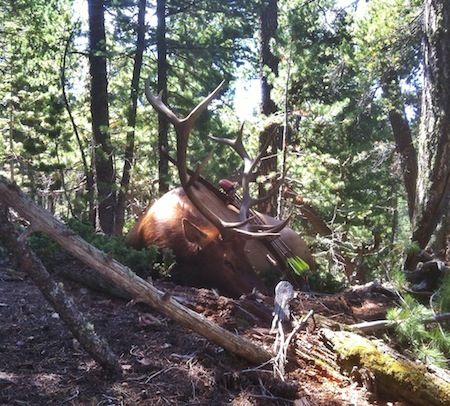 My extreme worry quickly melted away to a great sense of pride and elation. I did it! I took a mature bull with my recurve. I don’t think I could have done it without the aid of a treestand, since the bulls weren’t responding to calls. I’ll tell you, packing out an animal that size is no easy task for someone who lives at an elevation of 285 feet. Even under the weight of a backpack full of meat and the bull’s head gear, I couldn’t stop smiling. I couldn’t wait to send pictures to my friends and family back home. The Game Warden showed up a few days later, and I was greeted with all smiles and a congratulatory handshake. He looked at the antlers beside our tent with an expression of admiration and shock that a nonresident had pulled off a bull of that quality with a recurve. He said again, with colorful language, “You know I like a ‘big’ talker who can back up what he says.” We laughed again, and as I recapped my hunt over a cup of coffee, I was glad I had brought my southern style of treestand hunting out West to hunt the magnificent wapiti. When the elk aren’t responding to calls, and you’re in a dense area that makes it difficult to stalk mule deer, it’s not a bad idea to try hanging a stand over a well-used trail and giving it a sit. I’m sure glad I did, and I can promise you the next time I draw a tag, be it for elk or mule deer, I will be gathering my treestands and preparing them for another trip westward to visit old familiar trees.
My extreme worry quickly melted away to a great sense of pride and elation. I did it! I took a mature bull with my recurve. I don’t think I could have done it without the aid of a treestand, since the bulls weren’t responding to calls. I’ll tell you, packing out an animal that size is no easy task for someone who lives at an elevation of 285 feet. Even under the weight of a backpack full of meat and the bull’s head gear, I couldn’t stop smiling. I couldn’t wait to send pictures to my friends and family back home. The Game Warden showed up a few days later, and I was greeted with all smiles and a congratulatory handshake. He looked at the antlers beside our tent with an expression of admiration and shock that a nonresident had pulled off a bull of that quality with a recurve. He said again, with colorful language, “You know I like a ‘big’ talker who can back up what he says.” We laughed again, and as I recapped my hunt over a cup of coffee, I was glad I had brought my southern style of treestand hunting out West to hunt the magnificent wapiti. When the elk aren’t responding to calls, and you’re in a dense area that makes it difficult to stalk mule deer, it’s not a bad idea to try hanging a stand over a well-used trail and giving it a sit. I’m sure glad I did, and I can promise you the next time I draw a tag, be it for elk or mule deer, I will be gathering my treestands and preparing them for another trip westward to visit old familiar trees.
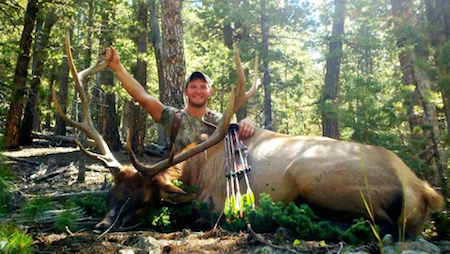 Author Bio: I have been bowhunting-only for the past 11 years, and traditional-only for the past three. I enjoy helping others get into the sport, and I am a moderator on tradgeeks.com, where I offer advice on bowhunting and traditional archery in general. I enjoy filming my hunts so that others can enjoy my experiences as well. I’ve lived in rural Louisiana my whole life, but I’ve traveled to Colorado every year since the age of two. I am also on Simmons Sharks ProStaff.
Author Bio: I have been bowhunting-only for the past 11 years, and traditional-only for the past three. I enjoy helping others get into the sport, and I am a moderator on tradgeeks.com, where I offer advice on bowhunting and traditional archery in general. I enjoy filming my hunts so that others can enjoy my experiences as well. I’ve lived in rural Louisiana my whole life, but I’ve traveled to Colorado every year since the age of two. I am also on Simmons Sharks ProStaff.
Equipment Note: At the time of this hunt I carried a 50# @ 29″ BlackWidow PSAIII recurve with Easton XX75 2413 aluminum shafts tipped with 175 grain Zwickey Eskimos, along with Gorrilla climbing sticks and treestands.


Leave A Comment